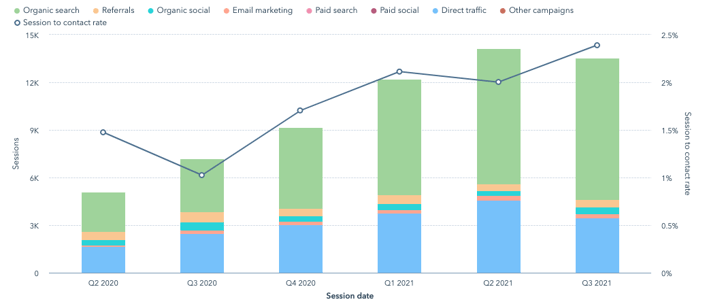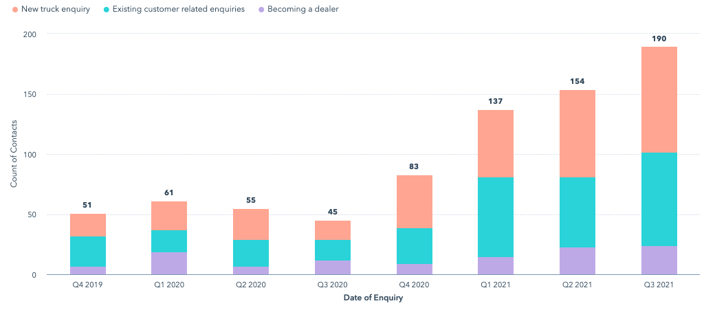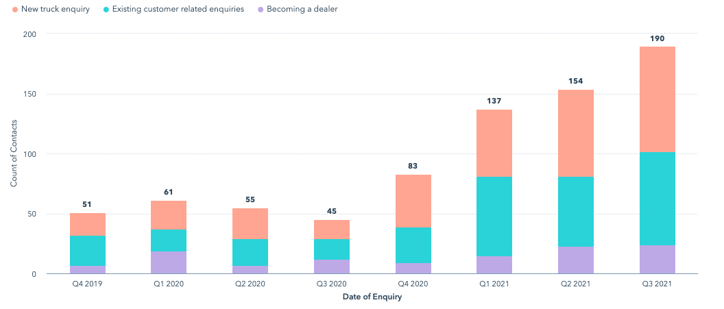In this Spotlight, we look at our forklift manufacturing client, TCM Forklifts, a brand of Mitsubishi Logisnext Europe BV, and how we helped them to generate a dependable stream of inbound marketing leads.
It’s probably the number one challenge we get asked to solve: how can you get more people to visit your website and convert into leads?
Every marketing team will recognise this challenge — particularly those in small or medium-sized companies looking to scale. But solving it is easier said than done, because there’s no one answer. The reasons for a lack of traffic and conversions can be many:
- Is the content getting found on search engines? (Look at traffic sources in HubSpot or your chosen analytics tool.)
- Is there a consistent content publishing schedule?
- Is the content being actively promoted? And is it being promoted to the right audience?
- Does each piece of content have a clear, relevant call-to-action?
- Is your website optimised for a simple user journey?
In TCM’s case, we identified that the key issues limiting website traffic and lead generation were the lack of SEO, an ad-hoc approach to content creation and lengthy conversion paths.
Once we’d solved this, we almost doubled annual web traffic from 7,220 to 13,562 sessions and achieved steady growth in lead volume too — up 322%.


If you’d like to achieve similar marketing results, read on to find out the steps we took!
1. Perform an SEO audit
The first thing we did for TCM was to use our go-to SEO tool, SEMrush, to perform a comprehensive SEO audit. The audit:
- uncovered duplicate content that was competing against itself
- found pages that couldn’t be crawled by search engines, limiting their reach
- identified broken links that were hindering SEO and site navigation
- highlighted potentially toxic domains that were pointing to the site
- provided the opportunity to add stronger-intent meta titles and descriptions at the optimal character/pixel length
We also used Semrush to set up keyword position tracking. Like us, you can use this to monitor how well you’re ranking for your most valuable keywords, so you can continually search-optimise your content to secure high positions (and more traffic).
2. Create a schedule of new articles including ‘evergreen’ content
Armed with comprehensive keyword research, one of our copywriters designed a content calendar. These resources are a cornerstone of our inbound marketing, giving us a schedule to work from while helping us to ensure our content plans are cohesive.
For this plan, we prioritised ‘evergreen’ content. Like the trees, these are articles and guides that will continue to have relevance over long periods of time (as opposed to trend-based, seasonal content with a short lifespan). Focusing on evergreen content would provide TCM’s blog with the solid foundation of search-friendly articles it needed to attract a steady stream of visitors over time — which in itself helps to improve SEO rankings.
To build an effective content calendar, our copywriter considered things like:
- who the target personas were
- what the key topics were, arranged as ‘pillar pages’
- what the sub-topics were, created as articles and aligned to the pillar pages
With the calendar reviewed and approved by the client, we were in a strong position to deliver a consistent stream of search-optimised content, informed by interviews with TCM’s subject matter experts and clearly aligned to TCM’s brand, products and values.
If you were taking on this task in-house, identify up-front who your copywriters can interview from the business to get the information they need, as well as who will write the article, who will be the published author, and who will be able to give the article a ‘second pair of eyes’.
3. Simplify conversion paths and build prominent CTAs
So, you’ve spent time auditing and improving SEO and creating a strategic content schedule to attract visitors to the website. Now you’ll need to consider how easily you can turn them into leads. That means guiding them to an enticing conversion point on your website.
Initially, visitors to the TCM website were around four clicks away from a conversion point. That’s four points where they could get distracted and either leave the website or go down a path that doesn’t help them convert to a lead.
To solve this, we went through each key page, including high-performing blog articles, and:
- ensured all CTAs were aligned to the right content subject
- added sidebar forms where relevant to give the opportunity for in-page conversions
- increased the prominence of CTAs, buttons and forms along the visitor journey
By taking this simple step across the site for existing and future content, we’ve steadily increased the number of inbound marketing leads coming through the website across the year:

4. Frequency and quality of social media posts
You’ll probably be well aware of the important role social media plays in generating website traffic. But, we had to include it in this article because it’s easy to think of the website and optimising content as separate to anything you might be doing on social media, when in reality these strategies are intertwined.
Once we’d built a strong content strategy for TCM, an essential part of the success was planning quality social media posts that were published at regular intervals.
There were a few key guidelines we followed, which you should follow too to make sure your posts are engaging no matter who your audience is — and what your subject matter might be.
- Always use a visual element in your post. Images are great, videos can be better.
- If you are using a video, make sure you include subtitles, improving accessibility and enabling people to absorb the content even with their sound off.
- Be direct. Attention spans are short. Tell them what they’ll learn by reading your content.
- Use hashtags, even on LinkedIn.
Increase the volume of leads you receive through inbound
Being able to take these individual steps might be easy, but delivering them as part of an overarching strategy that stays consistent even as resource levels — and business priorities — change is the real challenge.
TCM recognised the commercial advantage to leveraging a third-party marketing team to deliver repeatable, scalable results, month after month through an ongoing partnership.
If you’re looking at keeping your marketing in-house, here are a few tips for managing it day to day:
- Clearly assign ownership for making each element happen.
- Get someone to act as a project manager.
- Set up regular calendar events to run through your audit again.
- Consider contingencies - for example, if someone is assigned to write a piece of content and no longer has the capacity to do so, can you put another content piece in its place, or can someone else be assigned? Don’t let the regular schedule slip.
- If you’re struggling to find new things to post on social media, look back at your ‘evergreen’ content — or share content from partners.
If, like TCM, you’re looking for a partner to help you generate more inbound marketing leads for your business, get in touch today.
Heading
Separated they live in Bookmarksgrove right at the coast of the famous Semantics, large language ocean and many more stuff and more more more

Hollie is the in-house Marketing Manager at BabelQuest, an Elite-tier HubSpot Solutions Partner based in Abingdon, Oxfordshire.




.png?width=50)

.png?width=50)
.png?width=50)



































